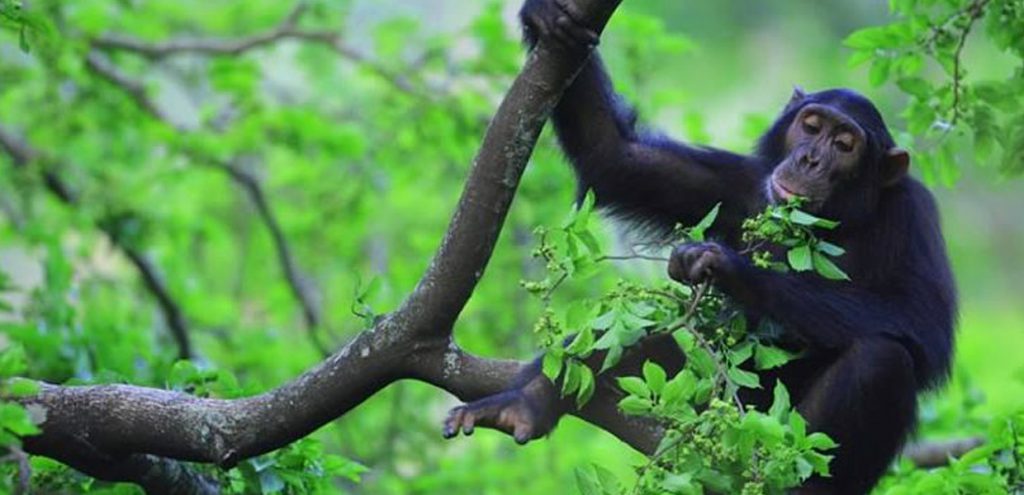Chimpanzees are undeniably one of the most exciting wildlife species in Uganda and no doubt must-visit by any primate lover. These creatures live in dense rainforests and surrounding areas with exciting social structures and most interestingly are close relatives in the animal Kingdom.

The experience of meeting face-to-face with these Great Apes in their natural habitat is unforgettable and unmatched and this is possible in the lush jungles of Uganda, within the East African region. While chimpanzees are overshadowed by mountain gorillas, these magical creatures are also interesting to visit and learn about their human-like behavior that will take your breath away. It is always a dream come true for many primate lovers to get up-close and personal with these Great Apes that are endangered and at the verge of getting extinct is their threats (diseases, poaching, habitat loss and encroachment) are not mitigated.
Chimpanzee trekking is one of the most popular tourist activities in Uganda and the beauty of seeing these Great Apes in the wild is that travelers have chances of seeing other remarkable wildlife species that share chimp natural habitats especially monkeys and birds.
How chimpanzee trekking is done in Uganda
Regardless of where you are trekking the chimpanzees from, you will be expected to converge at the Park Headquarters/Visitor Center for mandatory registration and briefing on the dos and donts of the activity. You will then enter the forest in the Company of an armed Ranger and experienced guide to search for the chimpanzee community and it will take one to three hours to finally encounter these Great Apes. Your several hours of walking is rewarded by a magical one hour of learning about their outstanding physical appearance, level of intelligence and social structures while photographing them play, groom each other, rest, mate or feed.
Where to enjoy chimpanzee trekking in Uganda
Chimpanzee trekking in Uganda is provided in over 5 places, but 3 safari destinations (Kibale Forest, Budongo Forest and Kyambura Gorge) are the most popular and therefore preferred by many primate lovers. Wild Chimpanzee populations can be tracked in Kibale Forest National Park, Toro-Semliki Wildlife Reserve, Kyambura Gorge (in Queen Elizabeth National Park), Budongo Forest (adjacent to Murchison falls National Park), and Kalinzu Forest while chimpanzees in captivity can be sighted in Ngamba Island Chimpanzee Sanctuary and Uganda Wildlife Education Center. Let’s look at the chimp trekking destinations on Uganda;
Kibale Forest National Park
This 795-square-kilometer Protected Area in western Uganda is a stronghold of over1500 of the 5000 chimpanzees in the country. This makes it the top chimpanzee trekking destination in Uganda. There are 95% chance of encountering these Great Apes during any of the two sessions-morning and afternoon. For only $200 per person for foreign non-residents, $150 for foreign residents or Shs. 150,000 per person for East African residents, you will acquire a permit that provides access to this remarkable safari destination.
Alternatively, you can part with $220 per person for the chimpanzee habituation Experience for a full-day experience to watch these Great Apes from the time they wake up (at 6:00am) to nesting (at 7:00pm).
Budongo Forest
Adjacent to Murchison falls National Park, Budongo Forest is another wonderful chimpanzee trekking spot allowing travelers to spice their encounter with mankind’s closest relatives with game drives, boat rides, hot air balloon tours, bush walks and sport fishing in Murchison falls National Park. For only $85 per person, you will acquire a permit from National Forestry Authority to trek these chimps in Budongo Forest, although there is an 80% chance of seeing them.
Kyambura Gorge
Kyambura Gorge, an isolated underground Forest in the eastern part of Queen Elizabeth National Park is also a wonderful chimpanzee trekking destination with 29 individuals. This makes it the 3rd best destination with 75% chance of meeting face-to-face with these Great Apes in their natural habitats and for only $50 per person, you are able to acquire a permit for chimp trekking in the “Valet of Apes”.
Toro-Semliki Wildlife Reserve
Toro-Semliki Wildlife Reserve is marked by dry and sparsely forested area and the chimpanzees here were habituated by a Japanese Research project. Given the nature of vegetation here, it is always difficult to find these Great Apes and there is a 50% chance as they have to roam far and wide to find food unlike in the dense rainforests like Kibale Forest National park and Budongo Forest.
Kalinzu Forest
There are presently about 40 chimpanzees in the dense forest of Kalinzu and the permits cost only $50 per person .The activity is managed by National Forestry Authority and there is a 75% chance of sighting these Great Apes in this natural environment.
Ideal time to go chimpanzee trekking in Uganda
There is no ideal time to go chimpanzee trekking in Uganda because the activity is available all-year round. However, different seasons offer different challenges or advantages. For the dry season- June to September and December to February, expect reduced precipitation levels hence drier forest trails but because this is the peak season, permits and accommodation are scarse thus booking at least 6 months is recommended.
For chimpanzee trekking in the rainy season, expect slippery and muddier hiking trails as rainfall levels increase but the advantage is that there is more food for the chimpanzees, thus treks are shorter. Also, you are likely to enjoy discounted rates provided by some accommodation facilities. However, Kibale Forest is generally a rainforest meaning chances of receiving rains even in the traditional dry seasons is inevitable. For this reason, you need to be prepared at all times by carrying a rain jacket, a waterproof backpack, a safari hat, sunglasses, hiking boots, gardening gloves in addition to cameras, insect repellants, binoculars and a first aid kit.
